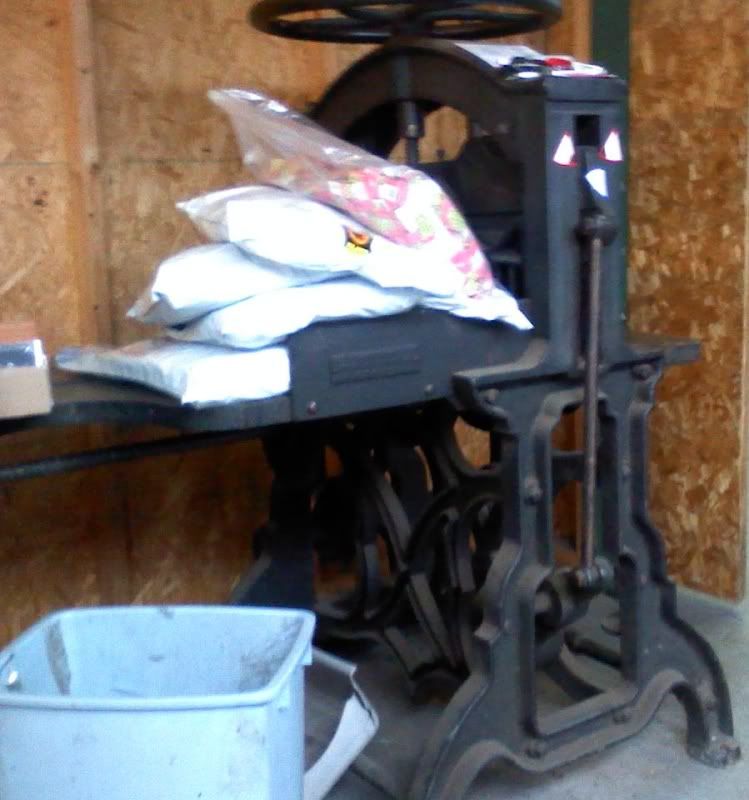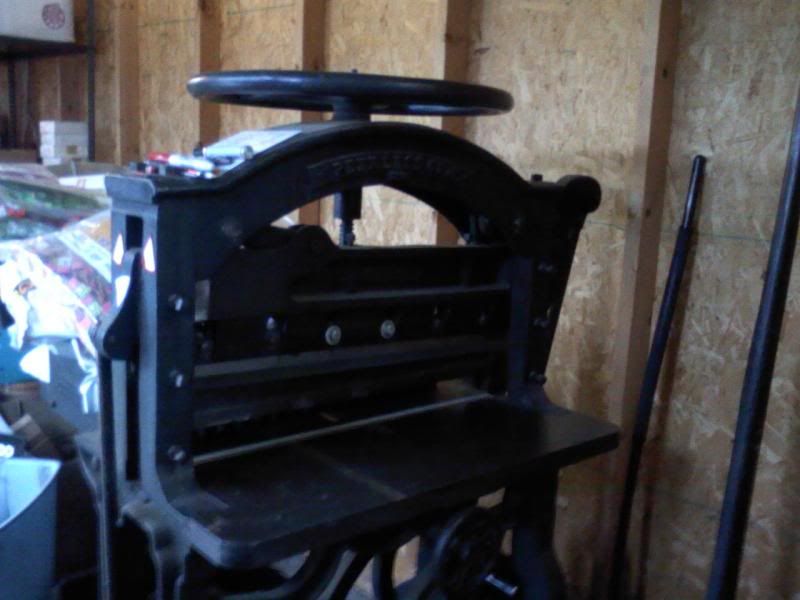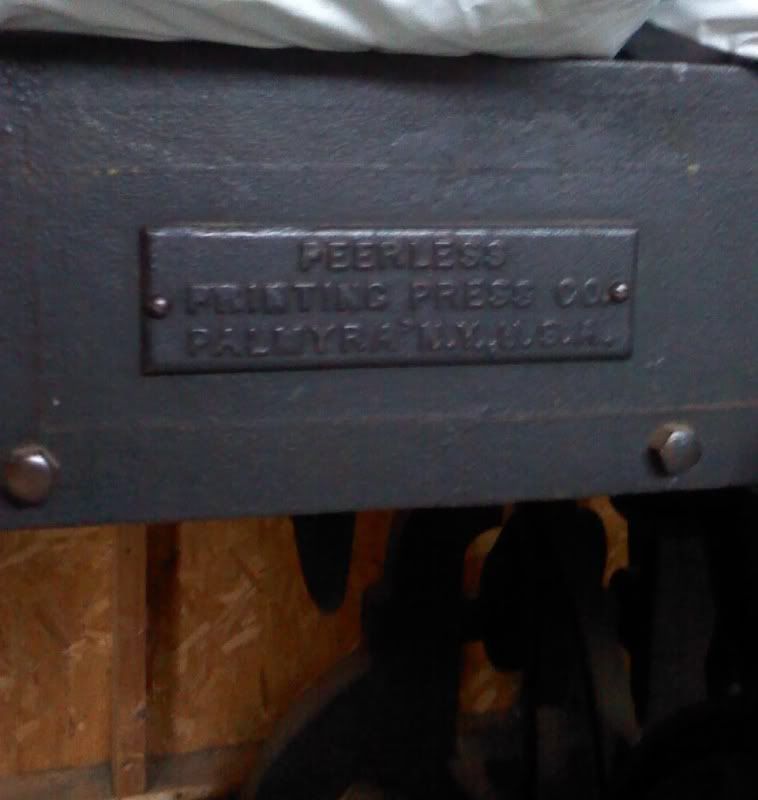|
|
|
|
#1
|
||||
|
||||
|
No. It hasn't been submitted yet. I just think both companies are scared to grade anything they're not sure of right now.
|
|
#2
|
|||
|
|||
|
I would say, since the card measures correctly and i'm thinking you measured top to bottom and side to side. Because it has all sharp corners, you should also measure diagonally corner to corner which most people don't, and do it both ways and the measurement needs to match exact both ways or its most likely trimmed. The only reason I mention this is that top border looks a little off. If they match, I'd give it a shot and have it graded.
|
|
#3
|
|||
|
|||
|
I used one of those about 40+ years ago. I worked for a small town newspaper that had been in business since the late 1800's...
The table had grooves lightly etched into it, a grid, like graph paper, that was of great help in aligning paper on the table. That big handle would be back over to the right, out of the way, while doing that. Depicted just under the handle and in the center of that table is a small wheel. That controlled a piece of metal that was at the back of the table. Turning it one way moved that piece, that stop, toward the front, turning the other way moved it back. We'd put the paper on the table, move that little wheel to adjust the depth, then move that big wheel at the top which lowered this big piece of metal to hold the material in place. Once it was down so the paper couldn't move, then we'd work that big handle to the left as it is shown. My recollection is that they kept a piece of wood between the blade and tabletop when it wasn't in use, to preserve the blade. It would slice through paper like, as they used to say in the hills around here, like a hot knife through butter. I agree, I think this would be what was used. It could cut with great precision with just a little bit of practice. |
|
#4
|
|||
|
|||
|
It's anyones guess how a grading co would handle a rough cut. It's a gray area, as a rough cut could be trimming, or just rough.
Here's the Needham I sent in. Sov 460, correct size, just rough top and bottom borders. The more I think about it, the more comfortable I am that they wouldn't assign a grade. A really close look will show it's not trimmed, but if they slab borderline or oddly made stuff it's trouble with people that arent familiar with some of the tecnical aspects of how things got made. I'd love to have seen it in maybe a 60 or more likely a 50 holder, but I can understand why they wouldn't. I wonder if they'd slab it with the MIS flip they printed? I've never seen one done that way and I figure I only got the MIS because I opted for no A slabs. I'd hope someday there will be a more detailed grading service that could make allowances for cards like this with factory but odd cuts, or cards that are factory but undersize. Steve B |
|
#5
|
|||
|
|||
|
Miscut and Trimmed are two different things. PSA uses the qualifier (MC) for miscut cards. A miscut would be a factory cut. Maybe better luck with a PSA slab since SGC doesn't have qualifiers and would only give an A grade.
|
|
#6
|
||||
|
||||
|
How are the diamond cuts explained?
Lee
__________________
Tired of Ebay or looking for a place to sell your cards, let SterlingSportsAuctions.com do the work for you, monthly auctions. |
|
#7
|
|||
|
|||
|
A diamond cut is a cut that slants at an angle usually left to right on the top and bottom of a card. So the card have a diamond shape. It happens because there is not enough surface area to clamp the cards down to cut them and they sometimes fan out at an angle when cut. Now when the next card is cut, its at an angle too because the cards are positioned smooth against the fence as explained in my first post. Usually once a sheet is cut at an angle, the rest are at an angle too. Just like building a house, if the first wall is tilted and everything else is measured from that tilted wall, then the whole house will be tilted.
|
|
#8
|
||||
|
||||
|
Doug, I don't think it would get a 7 or 8 anyway. The top left corner has a small problem, there is a white line running downward from the right elbow.
And the back has dirt or staining that will affect the grade Just things I saw, Joe.
__________________
 "Ty Cobb, Spikes Flying" "Ty Cobb, Spikes Flying"Collecting Detroit 19th Century N172, N173, N175. N172 Detroit. Getzein, McGlone, Rooks, Wheelock, Gillligan, Kid Baldwin Error, Lady Baldwin, Conway, Deacon White Positive transactions with Joe G, Jay Miller, CTANK80, BIGFISH, MGHPRO, k. DIXON, LEON, INSIDETHEWRAPPER, GOCUBSGO32, Steve Suckow, RAINIER2004, Ben Yourg, GNAZ01, yanksrnice09, cmiz5290, Kris Sweckard (Kris19),Angyal, Chuck Tapia,Belfast1933,bcbgcbrcb,fusorcruiser, tsp06, cobbcobb13 |
|
#9
|
||||
|
||||
|
I just got a couple of quick pics of this today. It looks similar to the one in the link.
  
|
|
#10
|
|||
|
|||
|
Awhile back I posted an article about American Litho, written shortly after the new facility was set up in 1897. Page 623 has a picture of the electric motor driven cutters installed at the time.
http://net54baseball.com/showthread.php?t=125899 Last edited by mkdltn; 01-25-2012 at 04:22 PM. Reason: link problem |
 |
|
|
 Similar Threads
Similar Threads
|
||||
| Thread | Thread Starter | Forum | Replies | Last Post |
| Rough Cut | mintacular | Postwar Baseball Cards Forum (Pre-1980) | 6 | 08-27-2011 02:47 PM |
| How does PSA grade hand cut cards? | Archive | Net54baseball Vintage (WWII & Older) Baseball Cards & New Member Introductions | 27 | 11-07-2007 02:59 PM |
| Cut from a sheet -Is that ok? | Archive | Net54baseball Vintage (WWII & Older) Baseball Cards & New Member Introductions | 33 | 06-03-2007 02:03 PM |
| REAL T206s | Archive | Net54baseball Vintage (WWII & Older) Baseball Cards & New Member Introductions | 3 | 01-09-2003 06:50 PM |
| Cut on the '33 Goudey cards | Archive | Net54baseball Vintage (WWII & Older) Baseball Cards & New Member Introductions | 2 | 02-21-2002 09:00 AM |